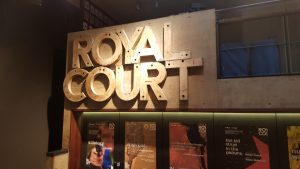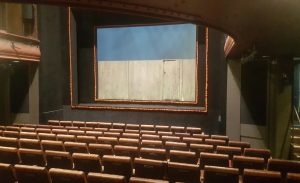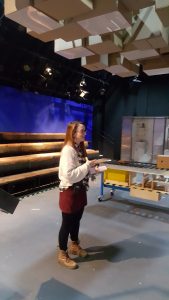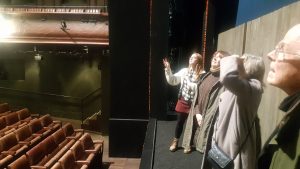BACK-STAGE VISIT
TO THE ROYAL COURT THEATRE, SLOANE SQUARE

A small group of members of The Chelsea Society were treated to a fascinating tour of the Theatre, both front of house and backstage on Saturday 11th February

Our very well informed guide was Eleanor, who explained the special role which the Royal Court plays, as a theatre which encourages little known playwrights from all over the world (including children) to submit their work with a reasonable chance that it will be performed. As they are not entirely dependent on box office receipts they can afford to take risks.

She also explained how the theatre makes great efforts to be inclusive in every way, and makes special arrangements for people who are disabled.

She explained the very intricate arrangements which enable the sets to be changed in a very limited space backstage.
There is a book about the Royal Court theatre “At the Royal Court: Twenty Five Years of the English Stage Company”– April, 1981 by
The first theatre on Lower George Street, off Sloane Square, was the converted Nonconformist Ranelagh Chapel, opened as a theatre in 1870 under the name The New Chelsea Theatre. Marie Litton became its manager in 1871, hiring Walter Emden to remodel the interior, and it was renamed the Court Theatre. Several of W. S. Gilbert‘s early plays were staged here, but the theatre closed in 1887 and was demolished.
The present theatre was built on the east side of Sloane Square, and opened on 24 September 1888 as the New Court Theatre. Designed by Walter Emden and Bertie Crewe, it is constructed of fine red brick, moulded brick, and a stone facade in free Italianate style. The interior was reconstructed by Robert Cromie, and the number of seats was reduced to under 500. The theatre re-opened in 1952, and was Grade II listed in June 1972.
George Devine was appointed artistic director, and the English Stage Company opened at the Royal Court in 1956 as a subsidised theatre producing new British and foreign plays, together with some classical revivals. Devine aimed to create a writers’ theatre, seeking to discover new writers and produce serious contemporary works. In 1956 Devine produced John Osborne‘s Look Back in Anger, a play by one of the “angry young men.” Osborne followed with The Entertainer, with Laurence Olivier in the lead as Archie Rice. Their premiere productions of Osborne’s A Patriot for Me, and Saved by Edward Bond (both 1965) necessitated the theatre turning itself into a ‘private members club’ to circumvent censorship by the Lord Chamberlain.
The Royal Court received a grant of £16.2 million from the National Lottery and the Arts Council for redevelopment, and beginning in 1996, under the artistic directorship of Stephen Daldry, and it was completely rebuilt, except for the façade and the intimate auditorium. The architects for this were Haworth Tompkins. The theatre reopened in February 2000, with the 380-seat Jerwood Theatre Downstairs, and the 85-seat studio theatre, now the Jerwood Theatre Upstairs, in recognition of the support given by the Jerwood Charitable Foundation http://www.jerwoodcharitablefoundation.org/



